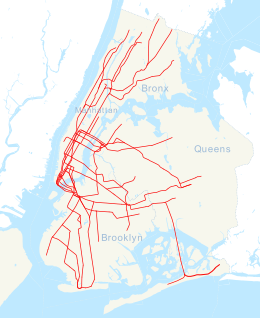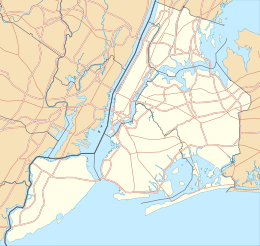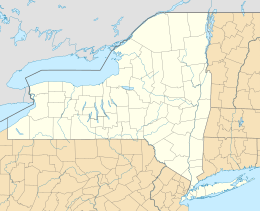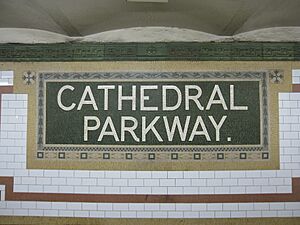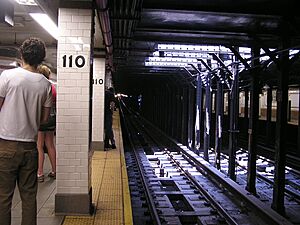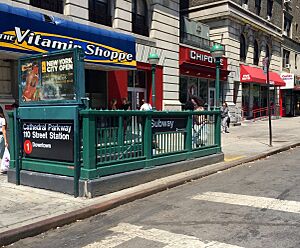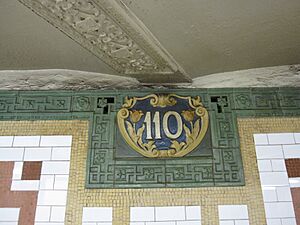Cathedral Parkway–110th Street station (IRT Broadway–Seventh Avenue Line) facts for kids
Quick facts for kids
Cathedral Parkway–110 Street
|
|||||||
|---|---|---|---|---|---|---|---|

Downtown platform
|
|||||||
| Station statistics | |||||||
| Address | West 110th Street (Cathedral Parkway) & Broadway New York, NY 10025 |
||||||
| Borough | Manhattan | ||||||
| Locale | Morningside Heights | ||||||
| Coordinates | 40°48′14″N 73°58′01″W / 40.804°N 73.967°W | ||||||
| Division | A (IRT) | ||||||
| Line | IRT Broadway–Seventh Avenue Line | ||||||
| Services | 1 alltimes (all times) | ||||||
| Transit connections | |||||||
| Structure | Underground | ||||||
| Platforms | 2 side platforms | ||||||
| Tracks | 3 (2 in regular service) | ||||||
| Other information | |||||||
| Opened | October 27, 1904 | ||||||
| Station code | 308 | ||||||
| Opposite-direction transfer available | No | ||||||
| Station succession | |||||||
| Next north | 116th Street–Columbia University: 1 alltimes | ||||||
| Next south | 103rd Street: 1 alltimes | ||||||
|
|||||||
|
|||||||
|
|||||||
|
|
|||||||
|
110th Street--Cathedral Parkway Subway Station (IRT)
|
|||||||
| MPS | New York City Subway System MPS | ||||||
| NRHP reference No. | 04001019 | ||||||
| Significant dates | |||||||
| Added to NRHP | September 17, 2004 | ||||||
The Cathedral Parkway–110th Street subway station is a local stop on the New York City Subway system. It's part of the IRT Broadway–Seventh Avenue Line. You can find it in Morningside Heights, Manhattan, where Cathedral Parkway meets Broadway. The 1 train serves this station all the time.
This station was built for the Interborough Rapid Transit Company (IRT). It was part of New York City's very first subway line, which was approved in 1900. Construction on this part of the line began on June 18, 1900. The station first opened on October 27, 1904. It was one of the original 28 stations in the New York City Subway. Over time, the station's platforms were made longer in 1948 to fit longer trains. The station also got a fresh look with renovations in the 2000s.
The 110th Street station has two side platforms. These are platforms on the sides of the tracks. It also has three tracks, but the middle track isn't used for regular trains. The station was designed with beautiful tiles and mosaics. You can exit the platforms onto 110th Street and Broadway. The two platforms are not connected inside the paid area, so you have to exit and re-enter if you need to switch directions. The oldest part of the station is a special New York City landmark. It's also listed on the National Register of Historic Places, which means it's an important historical site.
History of the Subway Station
Building New York City's First Subway
Plans for New York City's first subway line began way back in 1894. Engineers created a plan for a subway line that would go from New York City Hall in lower Manhattan up to the Upper West Side. From there, it would split into two branches heading north into the Bronx. This plan was officially approved in 1897.
In 1900, a company called the Rapid Transit Construction Company signed a deal to build the subway. They also agreed to operate it for 50 years. In 1901, the company Heins & LaFarge was chosen to design the underground stations. The Interborough Rapid Transit Company (IRT) was formed in 1902 to run the subway.
Construction of 110th Street Station
The 110th Street station was built as part of the IRT's West Side Line. This line is now known as the Broadway–Seventh Avenue Line. Construction for this section of the line started on June 18, 1900.
Originally, this part of the West Side Line was planned to have only two tracks. But in 1901, they decided to add a third track in the middle. This extra track would be used to store trains. Because of this change, some of the work that had already been done had to be redone.
Opening Day and Early Impact
The 110th Street station officially opened on October 27, 1904. It was one of the first 28 stations of the New York City Subway. The opening of this subway line, and especially the 110th Street station, helped the neighborhoods of Morningside Heights and Harlem grow and develop.
Changes and Upgrades Over Time
20th Century Improvements
After the subway system was finished in 1908, the 110th Street station served both local and express trains. To help with crowded trains, the city decided to make the station platforms longer. This project started in 1910. The northbound platform at 110th Street was made longer by about 135 feet. This allowed longer trains to stop at the station.
In 1948, the platforms on the IRT Broadway–Seventh Avenue Line were made even longer. They became about 514 feet long. This meant that full ten-car express trains could now stop at the station. Before this, longer trains couldn't open all their doors at the station. At the same time, the subway lines were given numbers. The Broadway/West Side route to 242nd Street became known as the 1 train. By 1959, all 1 trains became local trains.
In 1979, the original part of the station was named a city landmark. This means it's a special building that needs to be protected because of its history and design.
In 1988, the New York City Transit Authority (NYCTA) planned to make service faster by using a "skip-stop" system. This meant some trains would skip certain stations. When this started in 1989, the 9 train also served 110th Street on weekdays, along with the 1 train.
21st Century Renovations
In 2002, the Metropolitan Transportation Authority (MTA) announced plans to renovate ten subway stations, including 110th Street. The plan included updating the station's entrance areas, floors, and electrical systems. New lighting, public announcement systems, and stairways were also part of the project. Since 110th Street is a landmark, its historical features would be carefully repaired or replaced.
Columbia University discussed helping to pay for the renovation of the 110th Street station. They wanted the work to be done quickly. Local residents liked the idea of renovations but worried that rushing the work might damage the station's historic parts.
The MTA also planned to add new artwork to the station through its Arts for Transit program. However, some community members were against this. They worried the artwork might damage the original decorative tiles, which were part of the station's landmark status. The MTA had planned to put a small bronze subway track and train design into the station walls. They also wanted to add old photos of the neighborhood. After discussions, the MTA decided not to add new artwork to the 110th Street station.
Between October and November 2003, the downtown platforms at 110th Street and 125th Street were closed to speed up the renovation work. The original parts of the station were added to the National Register of Historic Places in 2004. The skip-stop service, which included the 9 train, ended on May 27, 2005.
Station Layout
This station has two side platforms. These are platforms on either side of the tracks. It has three tracks in total, but the middle one is an express track that is not used by regular trains. The 1 train stops here at all times.
The platforms were first about 350 feet long. After the 1948 upgrades, they became about 520 feet long. The newer parts of the platforms are at the southern ends of the original platforms.
Station Design and Art
Like other stations built during the subway's early days, the tunnel roof is shaped like a "U". This shape helps hold pipes and wires. The platforms are made of concrete slabs. Underneath them are drains for water. The older parts of the platforms have round, cast-iron columns that look like ancient Greek columns. The newer platform extensions have I-beam columns.
The walls along the platforms have a brick design at the bottom. Above that, they are covered with light-colored mosaic tiles. The walls are divided by vertical bands of salmon-colored tiles. These bands have blue plaques with the number "110" on them, surrounded by wreath designs. There are also green-and-white mosaic signs on the walls that say "Cathedral Parkway." These signs have buff, pink, and red designs around them.
The station's design was created by Heins and LaFarge. They were inspired by other projects they were working on nearby, like the Cathedral of St. John the Divine. The dark colors used in the station were inspired by the design of Columbia University's Low Library.
The downtown platform has two doors at its southern end that lead to rooms for telephones and electrical equipment. The uptown platform has closets in the area where you pay your fare. These used to be restrooms.
Exits from the Station
There is only one way to enter or exit the southbound platform. It's at the northwest corner of 110th Street and Broadway. For the northbound platform, you can enter or exit from both the northeastern and southeastern corners of 110th Street and Broadway. The staircases leading to the street are simple and modern, made of steel. The Cathedral of St. John the Divine is just one block east of the station exits.
- nycsubway.org – IRT West Side Line: 110th Street
- Station Reporter – 1 Train
- Forgotten NY – Original 28 - NYC's First 28 Subway Stations
Images for kids
See also
 In Spanish: Cathedral Parkway–Calle 110 (línea de la Séptima Avenida–Broadway) para niños
In Spanish: Cathedral Parkway–Calle 110 (línea de la Séptima Avenida–Broadway) para niños


